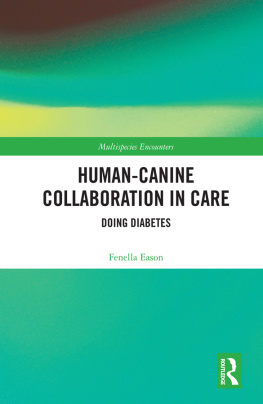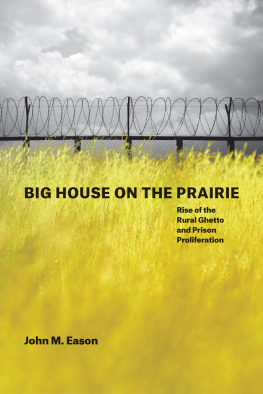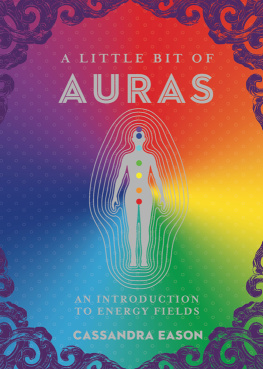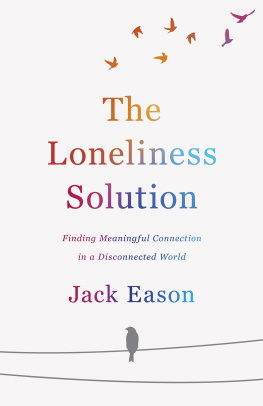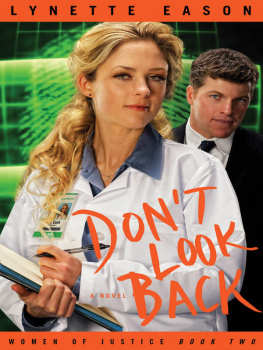Fenella Eason - Human-Canine Collaboration in Care
Here you can read online Fenella Eason - Human-Canine Collaboration in Care full text of the book (entire story) in english for free. Download pdf and epub, get meaning, cover and reviews about this ebook. year: 2019, publisher: Routledge, genre: Home and family. Description of the work, (preface) as well as reviews are available. Best literature library LitArk.com created for fans of good reading and offers a wide selection of genres:
Romance novel
Science fiction
Adventure
Detective
Science
History
Home and family
Prose
Art
Politics
Computer
Non-fiction
Religion
Business
Children
Humor
Choose a favorite category and find really read worthwhile books. Enjoy immersion in the world of imagination, feel the emotions of the characters or learn something new for yourself, make an fascinating discovery.
- Book:Human-Canine Collaboration in Care
- Author:
- Publisher:Routledge
- Genre:
- Year:2019
- Rating:4 / 5
- Favourites:Add to favourites
- Your mark:
- 80
- 1
- 2
- 3
- 4
- 5
Human-Canine Collaboration in Care: summary, description and annotation
We offer to read an annotation, description, summary or preface (depends on what the author of the book "Human-Canine Collaboration in Care" wrote himself). If you haven't found the necessary information about the book — write in the comments, we will try to find it.
Human-Canine Collaboration in Care — read online for free the complete book (whole text) full work
Below is the text of the book, divided by pages. System saving the place of the last page read, allows you to conveniently read the book "Human-Canine Collaboration in Care" online for free, without having to search again every time where you left off. Put a bookmark, and you can go to the page where you finished reading at any time.
Font size:
Interval:
Bookmark:
Mentally ripped out of their comfort zone by the unexpected tearing of their corporeal mantle, people often are forced to discover alternative modes of social existence and other resources that enable coping with newly shaped ways of being. One method of locating these is to talk of upsetting events and experiences with psychologists and physicians and with those who have had similar disruptions in their lives. Gradually and often uneasily, the altered selves are enabled to release stories of their embodied corruption and its forceful entourage of side effects. Sarah Nettleton exemplifies the significance of personal narrative: When people have the opportunity to give voice to their experiences of illness, it becomes evident that their accounts are woven into their biographies (2013: 73).
The voluntary participants in this study, who are accustomed through necessity to communicate personal illness and well-being issues to their family, work colleagues, and members of healthcare professions, are therefore enabled to narrate tales of medical and social upheaval in their own lives as a result of a Type 1 diabetes diagnosis. They relate personal stories of internal and external bodily damage and repair, they laugh when they might weep over the obstacles that beset them in society and at home, and they become grave when contemplating the life-changing experiences of others faced with unpredictable hurdles in similar minority groupings.
They are expert but vulnerable witnesses to the inconsistencies and uncertainties of their lives and are conscious of the need for ongoing medical and social practices. They recognise when things are out of synch within their embodied worlds and, often, how to get the external world to intervene so they may adapt and achieve safe passage onwards. They are explorers and adventurers, consultants and chemists, who traverse the world of chronic illness and, in so doing, reveal to others their best practices of self- and other-care.
But they are also conscious of their inability to recognise when their own fluctuating blood glucose levels are rising or falling to extremes. This loss of hyper- (too high) or hypoglycaemic (too low) awareness constantly endangers their lives.
Sources of increased self-confidence and of companionship in social reintegration are the diabetes alert assistance dogs who share the human home and give advance warning when blood sugar levels enter danger zones. Their keen sense of smell, combined with training by the charity Medical Detection Dogs (MDD) to perform active alarm signals, ensures the dogs retain a much-vaunted significance in the lives of their human partners. These are dogs (Canis familiaris) of diverse breeds and backgrounds credited by those with Type 1 diabetes with being lifesavers and confidence-boosters and as having full membership of their families and of the society in which their close interspecies relationships are situated. Adrian Franklin (2006: 142) relates this new concept, of companion animals viewed as belonging to and becoming family, to a hybridization of the family and not to imagined anthropomorphism whereby a dogs qualities and characteristics are observed as human-like (see also Milton, 2005). Importantly, the diabetes alert dogs are considered to be fully deserving of respect, recognition, and gratitude for their incomparable prowess in scent detection for human benefit. And the good-natured dogs seemingly acknowledge praise and reward, as is their wont, and accept the need to collaborate, tolerate, and enact the requisite behaviours as worthwhile and customary practices.
As Franklin contends:
Unproblematic similarities might include co-residence, enduring ties, emotional inter-dependence, friendship, company and shared activities. When this happens, it is important to realize that it is not a one-way, human-orchestrated attribution, but one built of close feelings and emotions self-evidently expressed also by the animals themselves.
(2006: 142)
Shared activities and hybridized practices are prominent in the daily routines of the species under focus here. These interactive human and nonhuman animal partners are the central figures performing on the ethnographic stage of this research into trans-species coexistences and the practices of normalising lives unsettled by chronic illness lives in bodies that fail to function as expected and desired in a human, but also lives that enable bodily adaptation, alteration, survival, and the creation of new identities through the exceptional sensory perception of a nonhuman animal. These closely united companions are actors whose lines, spoken and unspoken, and vivid images of life in chronic illness, animate and illuminate their interconnecting biographies. Following Irvine (2013: 5), their narrations become resources, helping us understand and share what we find meaningful and what gives us purpose.
The perspective of symbolic interactionism (Irvine, for example, 2004, 2007, 2012) is employed to disentangle the shared meanings from the symbiotic practices of care inherent in the coexisting partnerships that work within the bounds of chronic illness. The ecofeminist-derived ethics of care theory (Hamington, 2008; Adams and Gruen, 2014) supports exploration of interdependency and what it might be like to care and be cared for (Taylor, 2014: 109) in a symbiotic humannonhuman coexistence.
Ethics of care theory also enables questioning of the elastic moral boundaries that humans construct to differentiate between the use and the exploitation of others. A firm moral stance needs to be considered and activated to avoid abuse and cruelty in humannonhuman animal interactions. Symbiosis enables the pairing of unlike couples so that at least one member of the partnership gains benefit, be it improved self-worth, nutrition, or increased ability to achieve goals and rewards. Under the symbiosis umbrella huddle parasitism, commensalism, and mutualism (refer Leung and Poulin, 2008), and it is mutualism in this caninehuman coexistence that motivates and leads towards acceptance of certain morally justifiable interspecies usages. A respectful mutualistic form of usage can impel development of credible and ethical multispecies collaboration, even unification, when compared with the unethical exploitation of commodified nonhuman animal masses.
The importance of animal mattering (Irvine, 2013; Law, 2004; Rollin, 2011) is investigated to explore the question: how do chronically ill people engage with medical alert assistance dogs in their self- and other- care behaviours and in their lives? The responses offered by clients of MDD record and explore action and performance, the doings and reshapings of life with chronic illness, by themselves and their MDD-trained working canine companions as they together effect and experience best practices that maintain lives worth living, lives that matter to more than one lone being.
The complexities examined and resolved by these multispecies practitioners in their everyday lives enable a visible becoming of an emotional, familiar, and self- and other-respecting amalgamation a dyad identifiable as one-self. Gazing into, and reflecting on, these harmonising coexistences enables an ethnographic contribution to the social sciences, drawing attention to innovative multispecies health care practices and raising awareness of the multidisciplinary science of anthrozoology. Anthrozoology is a recent but significant addition to the social sciences, as John Bradshaw (2017) affirms in the title of his most recent volume: The animals among us: the new science of anthrozoology. It emphasises a present and future need for an ethics that is involved in, allows for, and advocates multispecies independencies and interdependencies.
Students in this fast-developing field explore the relationships and interactions whether collaborating or conflicting, whether bringing risk or gain to either or both that are shared by human and nonhuman animals. An attempt is made to avoid, as far as is possible, an anthropocentric bent and an ontological assumption that the other is an already fully known and understood being; further, there is effort to engage in self-reflection to encourage challenges to human interpretations and analyses of nonhuman animals.
Font size:
Interval:
Bookmark:
Similar books «Human-Canine Collaboration in Care»
Look at similar books to Human-Canine Collaboration in Care. We have selected literature similar in name and meaning in the hope of providing readers with more options to find new, interesting, not yet read works.
Discussion, reviews of the book Human-Canine Collaboration in Care and just readers' own opinions. Leave your comments, write what you think about the work, its meaning or the main characters. Specify what exactly you liked and what you didn't like, and why you think so.

